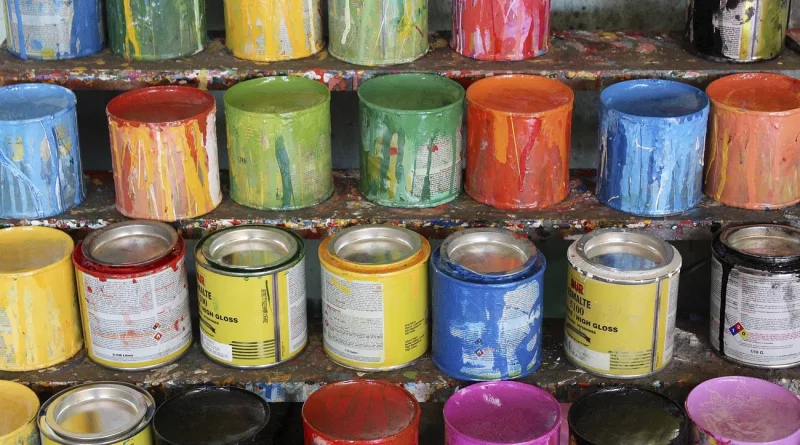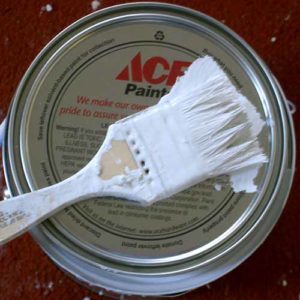How to Dispose of Paint in the UK
In the UK, the seemingly simple act of disposing of paint carries with it a weight of responsibility. Beyond the immediate need to declutter post-renovation, there’s a broader imperative: the environmental health of our nation and the legal mandates that govern waste disposal. Pouring leftover paint down the drain or tossing it in the bin isn’t just environmentally detrimental; it could also land you in legal hot water. As we delve into the nuances of paint disposal, we’ll explore its environmental impact and the UK’s specific regulations that every DIY enthusiast, homeowner, and professional should be aware of.
Understanding Paint Types
In the vast spectrum of the painting realm, it’s crucial to differentiate between the main paint categories prevalent in the UK. Each type offers a distinct finish and demands specific disposal techniques.
Water-Based Paints (e.g., Emulsions)
- Characteristics: Comprised mainly of water, these paints are more environmentally friendly and dry swiftly. They’re the preferred choice for most interior walls and ceilings.
- Disposal Method: Even with their lower toxicity, it’s not a good idea to pour them down the drain. For any remnants, let the paint dry inside its container or use absorbents to hasten the drying process. Once fully dried, it can be added to regular household waste.
Solvent-Based Paints (e.g., Gloss)
- Characteristics: Leveraging organic solvents, these paints produce a glossy finish, making them ideal for woodwork and metals. However, their higher volatile organic compounds (VOCs) content means they’re more environmentally hazardous.
- Disposal Method: Given their toxic nature, they shouldn’t be discarded down drains or in standard bins. The best approach is to take them to specific hazardous waste disposal sites in the UK. If only a minor amount is left, open the container and let it dry out before disposing of it.
Recognizing these variances is the initial step towards eco-friendly paint disposal, ensuring both the UK’s environmental safety clearing and compliance with local regulations.
Why Proper Paint Disposal Matters
Navigating the intricacies of paint disposal is more than just an afterthought of a DIY project or home renovation. In the UK, the stakes are high, and the reasons for proper paint disposal are multifaceted:
Environmental Concerns
- Water Source Contamination: Discarding paint irresponsibly can lead to it seeping into our waterways. This not only jeopardises the quality of our drinking water but also poses a significant threat to aquatic life.
- Wildlife Harm: Terrestrial and aquatic animals can inadvertently consume or come into contact with discarded paint, leading to potential poisoning or disruption of their natural habitats.
Health Concerns
- Chemicals and Toxins: Many paints, particularly those that are solvent-based, are laden with chemicals that can be detrimental if consumed or inhaled. When disposed of carelessly, these chemicals can permeate the soil, potentially contaminating crops and entering our food supply.
Legal Implications in the UK
- Fines and Penalties: The UK’s environmental agencies are stringent about waste disposal. Improperly discarding paint, especially if it results in environmental damage, can lead to fines. For businesses, these fines can be substantial, often reaching thousands of pounds. For individuals, penalties might include smaller fines, community service, or even legal action in severe cases.
Common Mistakes in Paint Disposal
When it comes to disposing of paint, many well-intentioned actions can lead to unintended consequences. Here are some of the most common mistakes people make, along with a few that might not be as widely recognized:
- Pouring Paint Down Drains: This not only risks blockages in household plumbing but can also contaminate local water sources, affecting both human and aquatic life.
- Throwing Liquid Paint in Regular Bins: Liquid paint can seep out, contaminating the ground and potentially harming wildlife. It can also complicate the waste processing at local facilities. Some waste recycling centres accept liquid paint.
- Storing Old Paint Indefinitely: While it might seem like a harmless act, keeping old paint can pose risks. Over time, containers can corrode or leak, leading to potential spills or exposure to harmful fumes.
- Not Checking Paint for Toxicity Before Disposal: Especially with older paints, there might be harmful ingredients like lead or mercury. Disposing of these without special precautions can be hazardous.
- Using Water to Thin Out Paint Before Disposal: Some people believe that diluting paint with water makes it safe for disposal. This is a misconception and can exacerbate the environmental impact.
- Disposing of Paint-Soaked Rags Carelessly: Rags or paper towels soaked in paint or solvents can be flammable and pose a fire risk if not disposed of properly.
- Not Utilizing Paint Recycling Programs: Many areas in the UK offer paint recycling or collection programs. Neglecting to use these services means missed opportunities for safe and eco-friendly disposal.
Disposing of Paint
For Unused Paint:
- Returning to the Store: If you have paint that hasn’t been opened or used, consider taking it back to the store. Many retailers accept returns and might even offer a refund or exchange.
- Donating: If returning isn’t an option, think about donating it. Community projects, local schools, or charities such as Community RePaint often welcome paint donations. It’s a great way to ensure the paint gets used and doesn’t go to waste.
For Used Paint:
- Drying Out Small Amounts: If you’ve only got a little bit of paint left in the can, the best approach is to let it dry out. Simply remove the lid and let it sit in a well-ventilated area until it’s dry.
- Using Absorbents for Larger Quantities: For non-empty paint cans that still have a significant amount of paint, you can speed up the drying process by adding absorbent materials. Sand, soil, or even cat litter can be mixed in to help solidify the paint.
- Dispose of Paint in the Right Way: Once your paint is dry, it’s essential to dispose of it correctly. Check with your local council to see if they accept dried paint in household waste. If not, they’ll guide you to the appropriate disposal facility.
For Paint Tins:
- Recycling Metal Tins: Empty metal paint cans, once cleaned and dried, can often be recycled. Place them in your household recycling bin or take them to a local recycling centre.
- Proper Disposal of Plastic Containers: Plastic paint cans require a different approach. While some councils might accept them in recycling, others don’t. It’s always best to check with your local council’s guidelines. If recycling isn’t an option, ensure the container is clean, dry, and dispose of it in your general waste bin.
Special Considerations
When it comes to paint disposal, there are certain aspects that require extra attention. Here’s a breakdown of these special considerations and how to address them:
Hazardous Paints and Thinners:
- Importance of Specialized Disposal: Not all paints are created equal. Some, especially older varieties or specific types, might contain harmful chemicals or metals. Similarly, paint thinners are typically hazardous. It’s crucial to ensure these are disposed of in a manner that doesn’t harm the environment or pose health risks.
- Local Hazardous Waste Disposal Centres in the UK: The UK has designated facilities specifically for the disposal of hazardous materials. Before disposing of any potentially hazardous paint or thinner, locate your nearest centre. They’re equipped to handle and process these materials safely.
Paint Rags and Brushes:
- Cleaning and Reusing: Instead of disposing of paint rags and brushes after a single use, consider cleaning them for reuse. For water-based paints, warm soapy water usually does the trick. For solvent-based paints, you’ll need a suitable paint thinner (like white spirit) for cleaning. Once cleaned, brushes should be reshaped and laid flat to dry.
- Safe Disposal Methods: If your rags and brushes have reached the end of their lifespan, ensure they’re disposed of responsibly. Rags soaked in paint or solvents can be a fire hazard. It’s recommended to place them in a metal container, soak them in water, and then seal the container before disposing of it. Brushes, once cleaned and dried, can typically be thrown away in general waste, but always check local guidelines to be sure.
Recycling and Upcycling Opportunities
In a world increasingly conscious of sustainability, leftover paint doesn’t have to be viewed as waste. Instead, it can be a canvas for creativity and community engagement.
Creative Uses for Leftover Paint:
- DIY Projects: From revamping old furniture to creating unique art pieces, there’s no limit to what you can achieve with a splash of leftover paint.Community Murals: Collaborate with local artists or community groups to beautify public spaces. A mural can transform a drab wall into a vibrant community showcase.
Platforms to Share or Exchange Paint:
- Freecycle: This grassroots platform allows members to give away items, including paint, to those in their local community. It’s a great way to ensure that your leftover paint finds a new home and purpose.
- Local Community Boards: Many communities have bulletin boards, either physical or online, where residents can offer items for free or trade. Posting your leftover paint here can connect you with local DIY enthusiasts or community projects in need.
Conclusion
As we reach the end of our guide, it’s vital to circle back to the core message: responsible paint disposal is not just about following rules; it’s about safeguarding our environment and communities. Every can of paint we handle correctly is a step towards a greener, more sustainable future.
FAQ
Can I take paint to the tip UK?
Yes, you can take paint to the local tip or household waste recycling centre in the UK. However, it’s essential to check with your specific local council beforehand. Some centres have specific areas for paint disposal, especially if the paint is hazardous. It’s always a good idea to keep the paint in its original container with the label intact, so the type of paint is easily identifiable.
Is it illegal to pour paint down the drain UK?
Yes, it is illegal to pour paint down the drain in the UK. Doing so can contaminate water sources, harm aquatic life, and disrupt water treatment processes. The UK has strict regulations regarding waste disposal, and improper disposal of old paint cans lead to legal consequences and fines.
How do you harden paint for disposal?
To harden paint for disposal:
- If there’s only a small amount of paint left in the can, simply remove the lid and let it sit in a well-ventilated area until it dries out.
- For larger quantities, you can speed up the drying process by adding absorbent materials directly into the paint can. Common absorbents include cat litter, sand, or soil. You can also use a professional paint hardener. Mix the absorbent into the paint until it thickens and begins to solidify. Once the paint is completely dry, it’s ready for disposal. Always check with your local council for specific disposal guidelines.



